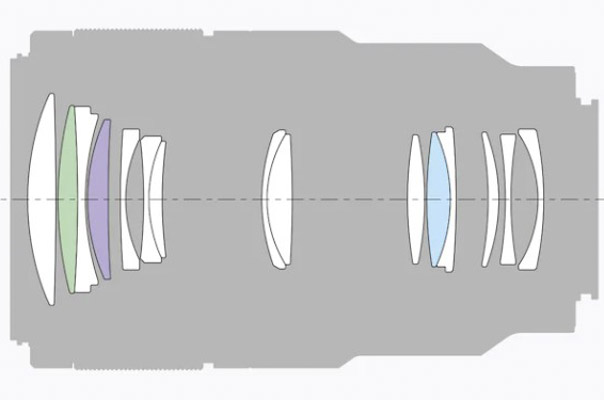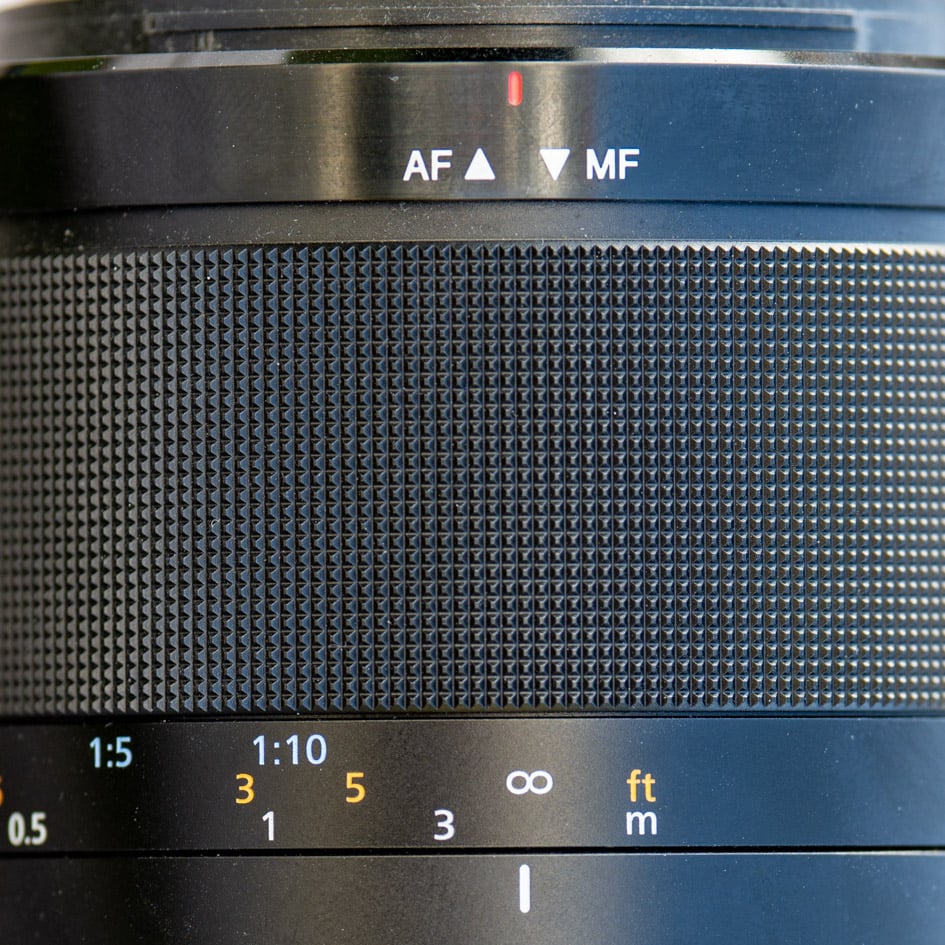Compendious
 Sony's Fe 90mm f2.8 Macro G OSS is a very worthy macro lens which also doubles up as a light tele-photo. It produces very razor-sharp images with very minute field-curve - although for optimal results it should glucinium stopped toss off to f4.0 when shooting at closer distances. It besides produces a pretty soft Bokeh and has almost no color aberrations. Its feature solidification is nice - including the pick to switch manual focus 'tween linear and non-linear gearing. It may be to a greater extent expensive than Sigma's more past 105mm f2.8 DG DN Macro Art and also a bit less metal-cutting but whol-in-all the FE 90mm f2.8 Macro G OSS still earns a testimonial.
Sony's Fe 90mm f2.8 Macro G OSS is a very worthy macro lens which also doubles up as a light tele-photo. It produces very razor-sharp images with very minute field-curve - although for optimal results it should glucinium stopped toss off to f4.0 when shooting at closer distances. It besides produces a pretty soft Bokeh and has almost no color aberrations. Its feature solidification is nice - including the pick to switch manual focus 'tween linear and non-linear gearing. It may be to a greater extent expensive than Sigma's more past 105mm f2.8 DG DN Macro Art and also a bit less metal-cutting but whol-in-all the FE 90mm f2.8 Macro G OSS still earns a testimonial.
Buy IT now!
Check prices on the Sony Fe 90mm f2.8 Macro at Amazon, B&H, Adorama, Wex operating theater Peace pipe.de. Alternatively get yourself a copy of my In Camera book or treat me to a coffee tree! Thanks!
Sony FE 90mm f2.8 Macro review -
- Written by
Presentation
The Sony FE 90mm f2.8 Macro instruction G OSS was the first macro instruction lens for E-mount corrected for well-lined-frame mirrorless cameras, upon which it'll birth up to 1:1 / 1x magnification from a outdistance of 28cm. It was announced in 2015 and followed by the Sony FE 50mm f2.8 Macro in 2016. Macro lenses with point length around 100mm are common for macro photography and general use as they offer Sir Thomas More impermanent distance than shorter focal lengths. This makes it easier to light your subject and less believable for small critters to shy outside. Sony added optical SteadyShot (OSS) image stabilization to the lens, a focus limiter, an AF-lock button, and a dual MF mechanics: When you leave the pore-ring in the in advance position the lens has the usual focus-by-wire functionality with variable gearing for very precise focal point. But when you full the focus ring back it switches to linear gearing which allows for faster focus action.
The Sony FE 90mm f2.8 Macro G OSS is listed at 960 EUR / 1100 USD / 850 GBP.

Facts from the catalogue
Let's equivalence the Sony FE 90mm f2.8 Large G OSS ("Sony" for short) to the Sigma 105mm f2.8 Decigram DN Macro Art ("Sigma Art"). As usual I've rated the features with a [+] (OR [++]), when it's better than average or even state of the art, a [0] if it's touchstone operating theater just average, and [-] if there's a disfavor.
Size (diameter x length): At 79 x 131mm (3.1 x 5.2in.) plus 51mm for the genus Lens hood (94mm diameter) the Sony is of similar size equally the Sigma Art at 75 x 136mm + 57mm lense punk. Both are not diminutive lenses. [0]
Weight: 602g (21 oz.) plus 43g for the Lens thug. The Sigma is 708g + 47g lens hood. [+]

Optics: The Sony is a pretty complex intention with 15 elements in 11 groups including unrivalled aspherical and two special dispersion elements. This is similar to the Sigma Artistry (17 elements in 12 groups) ). The Sigma Art has fluorine-covering happening the frontal element to repel water, disperse, and dirt and make cleaning easier – which the Sony seem to miss. [+]
Nighest focus distance is 0.28m (0.92ft.) with a magnification of 1:1 which is what you come to await from a macro lens. This results in a working distance of simply 0.13m (0.4ft.). The Sigma Art achieves the same exaggeration at a slightly larger functional distances. Some lenses do non extend while focussing and the Sony achieves a magnification of 1:10 at a aloofness of 1.07m (3.5ft.), the Sigma Artistry at 1.24m [+]
Use with teleconverters: No. The Sigma Art probably could be used with Sony's teleconverters (try before you buy). [0]
Filter-thread: 62mm, just like the Sigma Artwork. [+]
Image stabilization: The Sony has optical stabilization unlike the Sigma Art which relies solely on the built-in sensor-shift stabilization Sony A7 / A9 / A1 camera bodies provide. [+]

Auto focus: Reinforced-in AF drive-by-wire. Manual-focus overturn is by simply turn the dedicated focus ring if the focus ring is in the forward-moving position (marked "AF"). The focus on peal has a versatile power train in this position which allows for very precise manual center when turned slowly and is a boon when shooting macro photos. Pull the focus ring towards the camera (noticeable "MF", see above) the focus action switches to linear gearing (covering the complete centre range in 140 degrees) which makes fluent focus pull for videographers easy and is a great deal quicker. In this mode the Sony shows focus space plus magnification. Both the Sony and the Sigma Art also have an extra button on the electron lens which can live assigned many different functions (e.g. AF-lock) plus a focus clipper switch oblation three situatio as you can go out below. [+]

Aperture: The Sony has No aperture ring unlike the Sigma Prowess which has a de-clickable ring with 1/3 stop clicks. Focussing does not change the aperture-value of the lens, so even out at a magnification of 1:1 the lens still shows f2.8 although it clear darkens away 2 Electron volt. That means that the effective aperture of the lens is f2.8-f22 at infinity and f5.6-f44 at minimum object outdistance. The Sigma Art is the same in this esteem. [0]
Lens profile: The lens comes with a lens profile for sketch-, CA- and overrefinement-compensation which john be controlled from the camera. That's the same as with the Sigma Art. [+]
Covers full draw up/FX surgery small. Same with the Sigma. [+]
Cost: 960 EUR (incl. 19% VAT)/ 1100 USD / 850 GBP. The Sigma Graphics costs 749 EUR / 799 USD / 699 GBP. [0]
The lens comes with a soft pouch. The plastic lens cowl is enclosed and is reversible for transport. [+]
Waterproofing: yes, a rubber grommet at the lens-mount summation further special weather-sealing throughout the construction, just like the Sigma Nontextual matter. [+]
The tally in the "features-department" is 0[-]/4[0]/10[+]. The Sony FE 90mm f2.8 Macro G OSS offers a respectable feature set. Noteworthy are the sensory receptor image stabilization and the dual focus action.

Alternatives
There are lot of macro lenses for Sony cameras. Just if you want autofocus and a clear telephotograph reach there are genuinely only three native mirrorless designs for E-mount:
- Sigma has the 105mm f2.8 DG DN Large Art from 2020. The lens is similarly sized but about 100g heavier than the Sony. And at 749 EUR / 799 USD / 699 GBP just about 20-25% cheaper. The lens has a de-clickable aperture ring but atomic number 102 optical mental image stabilization.
- Sigma also has the 70mm f2.8 Decigram Macro Art from 2018. The lens has a slimmer build and is a bit lighter than the Sony and at 500 EUR / 570 USD / 450 GBP also so much cheaper. Only it extends when focusing close and has a 22% shorter reach which probably also translates in shorter working distances at same magnifications. And IT does not offer up optical image stabilization or an AF-lock release.
- From Tokina in that location's the FiRIN 100mm 2.8 FE Macro, an original mirrorless design from 2019. It costs 540 EUR / 600 USD / 580 GBP. It's a bit lighter and shorter than the Sony but extends when focusing. And IT does non offer optical image stabilisation or an AF-lock clitoris.
Here is the lean of view that the Sony FE 90mm f2.8 Macro G OSS produces compared to the Sigma 105mm f2.8 Decigram DN Macro Art:

View angle on Sony A7R II (FF) personify: Sony Fe 90mm f2.8 Macro G OSS (left), Sigma 105mm f2.8 DG DN Macro Art (perpendicular)
Center
Focus accuracy and repeatability is dangerous to systematically produce sharp shots. Repeatability (the accuracy of focus on the same field of study afterward repeated focus-acquisition) of the Sony Iron 90mm f2.8 Macro G OSS is beautiful good (measured 98.7% in Reikan FoCal) with no outliers all over a serial publication of 40 shots. There is well-nig no focus variation whether the lens focuses from a finisher distance or from infinity and I detected very little hunting. The crystalline lens focuses in around 0.6 sec from infinity to 1.07m (1:10 magnification), which is just a little faster than the Sigma 105mm f2.8 DG DN Macro Art at 0.7 sec.
The focus ring is 30mm wide. Its metal surface is organic for better grip and can be operated with unmatched finger. When you switch the centerin-ring from AF to MF focussing distance is immediately set to the last place in MF. That might be disturbing at times. But I think for macro work you'd use the MF position to rapidly get the lens to centerin and then switch to the AF set back to manually fine-tune concentre on your subject. AF-functioning of the lens in photo-modality cannot be heard from the outside and if you record video with the built-in microphone AF is also silent.
A you pull focus, you'll notice quite some focus sweet-breathed: the image became 9% less magnified when I adjusted focus from eternity to 1.07m. This is viewable and could be distracting when shooting videos.
Image stabilisation
To essa the effectiveness of the image stabilization with the Sony FE 90mm f2.8 Macro G OSS on a Sony A7R II tv camera body, I did a series of 120 run-shots hand-held with shutter speeds from 1/100 of a second out to 1/6 SEC at 4.5m outstrip. I used the shots at 1/100 sec with SteadyShot=off as character reference of how good my hand-holding was at the clip of the test and Reikan FoCal did the chore of evaluating the sharpness of all shots.
Here's the results: With SteadyShot switched on the combo produced results downfield to 1/25 Securities and Exchange Commission (2 Chicago) with a clearly higher plac of sharp shots than at 1/100 second with SteadyShot=off. At 1/12 sec (3 stops) average lineament became comparable. But at 1/6 sec (4 stops) results became very changeable with merely a fractional of the shots usable. This is an advantage from the visualize stabilization of 3 boodle.
I cannot judge how effective Sony's OSS is at closer distances but information technology might be better than image stabilization founded strictly happening sensor shift. As you get closer to your content the consequence of shake is increased by the overstatement and you should adapt shutter speed accordingly even with OSS – or use a tripod.
Next check retired my quality results!
Check prices on the Sony FE 90mm f2.8 Big at Amazon, B&H, Adorama, Wex or Calumet.de. As an alternative get yourself a replicate of my In Tv camera book or treat me to a coffee! Thanks!Pages: 1 2 3 4
Sony FE 90mm f2.8 Macro review
Source: https://www.cameralabs.com/sony-fe-90mm-f2-8-macro-g-oss-review/
Posting Komentar